The Animals and Their Trainers
Since animals play an important part in the films of
Johnny Weissmuller, it seems appropriate to devote a page to them. We
will attempt to answer the question: Where did the animals and their
trainers come from?
To answer that question, a good starting point is the
history of the most important source of animals for the movies: Goebel's
Lion Farm. Such was the first name of the area in Thousand Oaks,
California where Louis Goebel moved after leaving Universal Pictures.
Goebel was born in Buffalo, New York in 1896. In 1919
he moved to California and worked at Gay's Lion Farm. The following
year, he got a job at Universal Pictures and he lived on the grounds.
When the studio closed down its zoo. Goebel bought six of the lions
(Andy, Min, Bill, Momma and Little Caesar) and moved to Thousand Oaks.
|
He bought five lots in the Oak Springs development by
the Ventura Highway (now Thousand Oaks Boulevard) at $10 a lot and
moved in, building the animal cages himself. The noise from the cats
disturbed neighbour Kathleen Parks, and she went over to complain.
Instead she ended up marrying him six months later.
The Lion farm became a popular place; even circuses
wintered there and put on free shows for the tourists.
In 1931, Goebel took his animals out to the Lake
Sherwood area where Tarzan the Ape Man was being shot and
camped there to be certain his animals would be hired.
Goebel's Lion Farm eventually changed its name
to Goebel's Wild Animal Farm. |
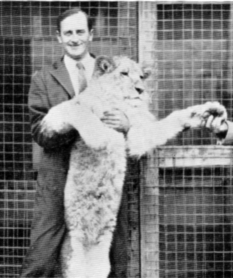
Louis Goebel and friend |
On July 8, 1940, a fire started in the hay barn and
swept through the compound, injuring six Bengal tigers and two of the
elephants, all of whom had to be put down. One of the elephants,
Sally, had panicked when she was slightly burned and stumbled into an
arroyo from which she was unable to extricate herself. She had to be
destroyed rather than burn to death, as did Queenie, another elephant
who was burned about the head and ran blindly into a tree. According
to a news account, Queenie tripped over the main water line, breaking
it, and ironically making it more difficult to extinguish the fire.
The head trainer Louis Roth was devastated.
One of the other elephants, Bonnie, who survived the
1940 fire, was killed in another fire while en route to the
Centennial Fair in Salt Lake City in July 1947.
Queenie had become somewhat of a celebrity when she
pushed free a school bus that had become mired in the mud. She and Sally had
been acquired by MGM through the studio's Publicity Head in 1935 for $3000
each. Queenie appeared in Tarzan Escapes, as the treehouse elevator
operator, and again as a dying elephant in Tarzan Finds a Son! And she was
disguised as a woolly mammoth for One Million B.C., the Victor Mature
starrer.
When MGM brought three young elephants from Siam, Whitbeck insisted that two
of them take the names of Queenie and Sally. The third one was christened
Happy. One or more of them appeared in Tarzan's Secret Treasure, Tarzan's
New York Adventure, Tarzan Triumphs, Tarzan's Desert Mystery and Tarzan and
the Amazons.
In 1947, Whitbeck purchased the pachyderm trio from the studio when they
were no longer needed for films, and began having them work in circuses.
In 1945, Goebel sold his animal compound to Trader
Horne, a Kansas City animal importer-exporter, and Billy Richards.
They renamed it the World Jungle Compound and in 1956 they
sold it to 20th Century Fox. It was again renamed, this time Jungleland.
One of the animals Horne brought back from Africa for
his new venture was a chimp named Peggy, to be trained by Henry
Tyndall. The clever animal won 2nd place in the 1953 Patsy Awards for
her role in Bonzo Goes to College. She also played Tamba in
the Jungle Jim features and Kimbbo in the Bomba films.
|
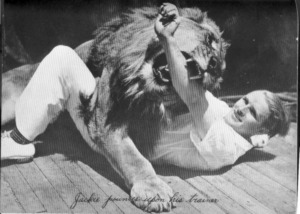
Mel Koontz and Jackie the Lion |
Other animals were Satan and Satan, Jr., tigers
trained by Mel Koontz, and a baby elephant named Tusko.
Melvin Koontz received his training at the old Selig
zoo, and took a trained animal act to the World's New York Fair in
1939, coming to the World Jungle Compound in 1946. He became
their chief animal trainer, remaining there until his retirement in 1964.
When the group defaulted, Goebel reacquired the
property in 1961. But money problems plagued the family for years,
and eventually Jungleland closed its doors for good. |
Mel Koontz and his lion appeared
in some of the RKO Tarzan films, and was a regular trainer for
Katzman's Jungle Jim features. He also “fought” a black
leopard named Dynamite in later entries.
Allene Gates, who was married to
Johnny during the Columbia period, recalls a unnerving scene that
took place when they were shooting the initial Jungle Jim film.
Jackie the lion was to be used in a scene in which Kolu falls into a
lion trap and Jim has to go in and fight the animal. While the scene
was being set up, she and actor Rick Vallin were seated in
directors’ chairs just off the set. Suddenly they heard Koontz
yell “Nobody move!”
Something had attracted Jackie and
he was heading towards the directors’ chairs. Jackie kept moving
towards them and Allene started saying, frozen with fear,
softly,“ No, Jackie, No Jackie. ” Jackie came over and
licked her on the face, then moved to Rick and started licking off
his body makeup. Allene recalls thinking that Jackie's head was
larger than the directors’ chair in which she was sitting.
Koontz also was a regular on the
Pinky Lee Show in 1956.
Louis Roth
Born around 1885, Louis Roth came from Hungary when he
was twelve, anxious to earn easy money in a land where streets were
paved with gold. It didn't take him long to realize that was not the
case, but his driving ambition and his reluctance to return to his
native Hungary unsuccessful spurred him on, and quite by accident he
got a job as a cage cleaner at the Louis Ruhe Wild Animal Farm
at Woodside, Long Island.
|
Later he worked on Coney Island for Frank Bostock, the
famous exhibitor of wild animals, and Herman Weeden, Bostock's chief
trainer. Here he began his apprenticeship as a trainer of cats. From
there he went to Bellevue, New Jersey, to be employed as an animal
trainer at the Bartell Wild Animal Farm.
His next stop was with the Rawlins Show with which he
remained until it disbanded. Finally he met up with the A. G.
Barnes Circus, with which he was to remain until its owner sold
the circus and retired.
His instinctive ability as an animal trainer stood him
in excellent stead, and soon he was not only training animals but
also animal trainers, such as Clyde Beatty, Bert Nelson, Mabel Stark
and Nellie Roth.
Before long he met Betty Kenyan, a horse trainer, whom
he married.
When Barnes sold his circus, Louis Roth went to
California to become chief animal trainer at the Selig Zoo in Luna
Park. This introduced him to the world of the cinema, and soon he
found himself working with animals in the movies. He and Betty bought
a ranch, and he went to work for Louis Goebel, becoming his chief
animal trainer. He remained in this position until his retirement. |
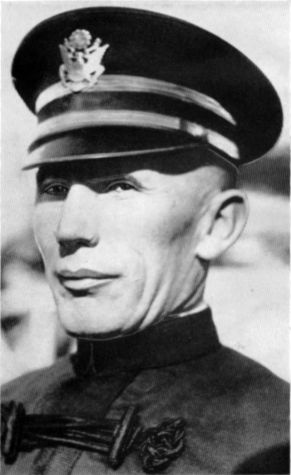
Louis Roth |
Al Antonucci
|
By 1944, George Emerson and the MGM chimps were
no longer available to Sol Lesser and he had to look
elsewhere to replace Cheta, the chimp. Johnny Sheffield
remembers that downtown parking lot owner, Ed Learmont,
had a chimp named Jimmy, so all they needed was a trainer.
Enter Al
Antonucci, a former trainer for the St. Louis zoo. For the
next three Tarzan pictures Jimmy, under his able mentor Al,
gave one of the best performances as Cheta imaginable.
With an expressive face and comedic talent, Jimmy stole the
scene whenever he was in it. One particularly engaging
moment occurs in Tarzan and the Huntress, when
he tries
to steal Tanya's powder puff. Monak fires a
knife in his
direction then pulls it out under the simian's nose.
The chimp does a triple take that would have made
W. C. Fields proud.
To see more pictures of Jimmy, click
here. |
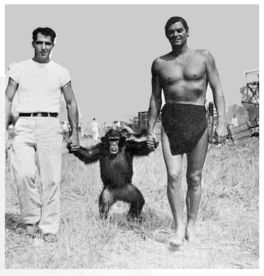
Al Antonucci, Jimmy and Weissmuller |
Damoo Gangaram Dhotre (1902 - 1973)
|
This international trainer of wild animals born in
India was contacted by Sam Katzman in 1948 when he was preparing his
first Jungle Jim film. He was asked to double Johnny Weissmuller
battling a leopard near the film's opening. The following is the
account of the episode as told to ghost writer Richard Taplinger.
“... I accepted the contract, which involved a
large amount of money, and taught Sonia [ his leopard] first to climb
a tree on the set, and then to jump down when she was told to. Then,
locking my arms around her, we practised rolling over several times,
and then I taught her to lie quietly while I apparently choked her.
This wasn't quite as easy as it may sound. Since leopards naturally
attack their prey by leaping at them from trees, I was afraid that
the leap might well awaken all Sonia's jungle memories. And so,
during our first few practice sessions, I had an ample supply of meat
which I gave her when she jumped. I don't pretend to know what went
on in her mind, but we had been working together for many years, and
I suppose she was learning by now all the sometimes silly things that
an animal is asked to do by her trainer.
Feeling smug and satisfied with myself because Sonia
had learned so well, I made an almost fatal mistake.
The day for shooting the scene arrived. Leaving Sonia
up in the tree I stepped off the set and, for the first time, put on
my make-up. Since I had to look like the movie star, my dark skin had
to be whitened, and I was smeared all over with white greasepaint. If
I hadn't been so sure of myself and had stopped to think for a
minute, this would have worried me, because an animal recognizes you,
first by smell, and second by sight. I obviously smelled different,
and I certainly must have looked strange.
I stepped onto the set and the cameras began grinding.
I talked to Sonia as I had during rehearsals, but I sensed that she
was acting peculiarly. She looked at me differently, and there was
the beginning of a growl coming out of the tree.
I gave her the order to jump and she did.
Like a flash of lightning she was out of the tree and
down on the ground in front of me, and I suddenly realized she wasn't
acting. It took me only a split second to know that she was
attacking. Her face was distorted in a snarl, and her claws were open.
In the split second when I realized that she didn't
know me I began talking as I have never talked before, in a desperate
effort to win recognition before her one final deadly leap.
It worked. Over the years we had talked together so
often and so earnestly that the sound of my voice breaking through
the strange odor and the strange appearance won her back. We
continued the act, ending in my ‘killing’ Sonia. But it
nearly ended the other way .”
The scene was reused in Fury
of the Congo three years later.
|
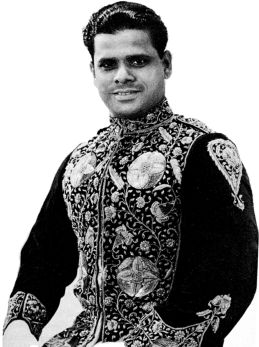
Damoo Dhotre

Sonia leaps from a tree
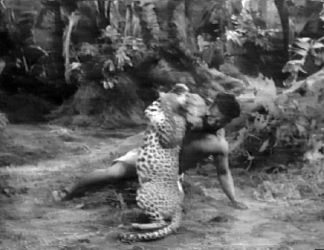
Dhotre as a luckless native
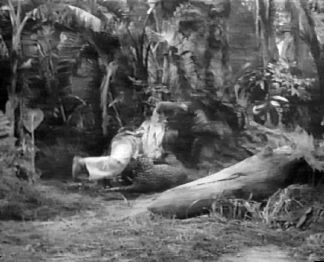
Dhotre stunts for Weissmuller |









